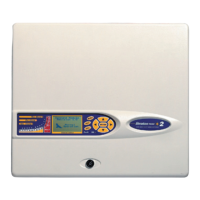Page 4
Stratos HSSD-2 • INSTALLER’S HANDBOOK • Iss. 12
The Standard Detector may be operated as a stand-alone unit, or may be part of a
network of detectors centrally monitored by a Command Module (see section 1.2).
It may be programmed via the front panel as in the version shown above. Alternatively,
and for detectors ordered without front panel display, the detector may be pro-
grammed remotely via the detector’s RS485 terminals using a Command Module, or
via the detector’s RS232 port using a PC running Remote Control software. A copy of
this software is packed with each detector supplied.
1.1 Standard Detector
1.2 Stand alone
Command Module/
Command Module
detector
1. Types of
Detector
When multiple detectors are networked together, a Command Module may be used
to tie all the detectors together and to provide a central point for programming,
running diagnostics and PC and fire panel connection.
The Command Module can be mounted either inside a detector as shown or as a
stand-alone unit in its own housing without an aspirator or smoke detection circuitry.
If detectors attached to the Command Module are mounted in different fire zones
then the Command Module must be mounted in its own housing with separate power
supply to comply with BS5839 and EN54.
When a Command Module is mounted inside a detector, the Standard Detector display
is replaced with a dedicated Command Module display. The programming buttons and
display on the front of the detector belong to the Command Module.
Programming from the Command Module is very similar to programming a detector,
the main difference being that the Command Module has extra functions to control all
the Stratos detectors connected to the detector loop.

